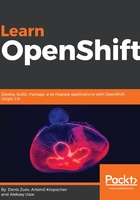
Application and service isolation
Imagine a scenario where we have ten different applications hosted on the same server. Each application has a number of dependencies (such as packages, libraries, and so on). If you need to update an application, usually it involves updating the process and its dependencies. If you update all related dependencies, most likely it will affect the other application and services. It may cause these applications not to work properly. Sure, to a degree these issues are addressed by environment managers such as virtualenv for Python and rbenv/rvm for Ruby—and dependencies on shared libraries can be isolated via LD_LIBRARY_PATH—but what if you need different versions of the same package? Containers and virtualization solve that issue. Both VMs and containers provide environment isolation for your applications.
But, in comparison to bare-metal application deployment, container technology (for example, Docker) provides an efficient way to isolate applications, and other computer resources libraries from each other. It not only provides these applications with the ability to co-exist on the same OS, but also provides efficient security, which is a big must for every customer-facing and content-sensitive application. It allows you to update and patch your containerized applications independently of each other.